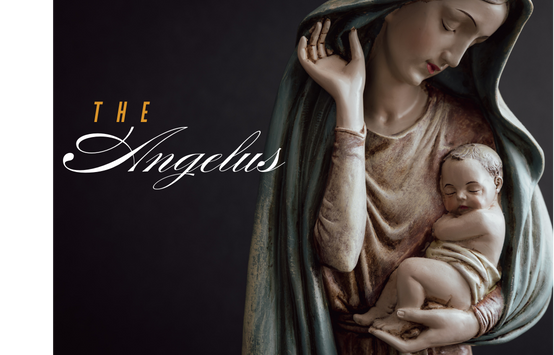Taking A Pause
'Hail, full of grace, the Lord is with you' (Lk 1: 28)
'Blessed are you among women, and blessed is the fruit of your womb'
(Lk 1: 42).
Blessings to all on this Month of Mary!
My first encounter with the beautiful and deeply reverent prayer of the Angelus took place at a Catholic Summer camp back in the summer of 1985. I had just graduated from High School, and there I go again, dating myself with that mention! At the camp, I served as a Nature counselor, a role in which I was responsible for the care of the various animals on site. Who would have thought back then that this experience would be a precursor to my eventual path as a future Franciscan?
As the bells rang at twelve o'clock, (The ringing of the Angelus bell is a significant part of the tradition, signaling the time to pray and reflect.) everyone at the camp paused from whatever activity they were engaged in, and I distinctly heard the prayer resonate through the sound system. It prompted me to reflect on the significance of such a moment.
What is the intricate history of the Angelus? The Angelus prayer derives its name from its origins: the prayer was originally recited in Latin, and the word "angelus" is Latin for "angel." It consists of a set of three antiphons that invite reflection on the Incarnation of Christ, particularly during the Annunciation. This profoundly holy moment is when the Angel Gabriel delivered God’s invitation to Mary, asking her to become the mother of the Messiah, and her response was a heartfelt and courageous yes.
L’Angelus (The Angelus) and was painted by Jean-François Millet in the mid-19th century.
This painting beautifully depicts two humble peasants who are taking a moment to pause in a vast field to engage in prayer. This serene scene is inspired by Millet's cherished childhood memory of observing his grandmother as she would often take a break from her labor in the fields to offer her prayers. The artwork captures not only the spirituality of the moment but also the deep connection to his family's values and traditions, highlighting the significance of prayer in the lives of these hardworking individuals.
The devotion originated in the Middle Ages when the laity imitated monks and nuns praying the Liturgy of the Hours. They would stop to pray together upon hearing bells at 6 a.m., noon, and 6 p.m. It evolved over time, lacking a single originator. The practice includes biblical prayers and ends with a petition from the Fourth Sunday of Advent, centering on three Hail Marys. This ancient practice is recommended by many saints, including St. Anthony of Padua and St. Mechtilde, who was told by the Blessed Virgin Mary, “I want you to say three special Hail Marys to me every day.
The devotion evolved over time and has no single origin. Pope Benedict XIV, during the liturgical year of 1742, asked that the Regina Caeli be prayed in place of the Angelus during the joyous season of Easter. This significant request led to a tradition that we continue to observe today.This beautiful devotion to the Blessed Virgin Mary includes praying three Hail Marys, known as the triple Hail Mary. This ancient practice has been endorsed by many saints like St. Anthony of Padua and St. Josemaría Escrivá. The Blessed Virgin Mary instructed St. Mechtilde to recite three special Hail Marys daily. (from the Catholic digest)
The Angelus Prayer serves as a meaningful reminder that Mary stands as a genuine and inspiring model for our own journey of discipleship; we sincerely hope that, like her, we may wholeheartedly say a complete YES to God with a profound sense of joy, unwavering hope, and deep trust in His divine plan. As we reach out to our family and friends, inviting them to pray for us during our journey of faith, we also humbly seek the intercession of Mary, asking her to pray for us and to draw us ever more deeply into a closer relationship with her Son.
The Angelus Prayer
The Angel of the Lord declared to Mary:
And she conceived of the Holy Spirit.
Hail Mary, full of grace, the Lord is with thee; blessed art thou among women and blessed is the fruit of thy womb, Jesus. Holy Mary, Mother of God, pray for us sinners, now and at the hour of
our death. Amen.
Behold the handmaid of the Lord: Be it done unto me according to Thy word.
Hail Mary...
And the Word was made Flesh: And dwelt among us.
Hail Mary...
Pray for us, O Holy Mother of God, that we may be made worthy of the promises of Christ.
Let us pray:
Pour forth, we beseech Thee, O Lord, Thy grace into our hearts; that we, to whom the incarnation of Christ, Thy Son, was made known by the message of an angel, may by His Passion and Cross be brought to the glory of His Resurrection, through the same Christ Our Lord.
Amen.
" Ave Maria, Totus tuus" or "Totally yours"
Keep at it! Keep praying. Love the Lord.
Peace and Grace.

